
This year, for various reasons, we have done almost no gardening. The garden is full of wildflowers. Wild, as in wild and out of control. More...
Most spectacular are the seven foot high stands of Common Ragwort, Senecio jacobaea. Like most people, I grew up with the belief that Ragwort is so toxic if you look at it you will die. It isn't, although I wouldn't want to eat a whole plateful. The Ragwort is a joy, constantly buzzing with insects around the clock - a couple of nights ago after dark I counted 12 species of micromoth on it in under an hour. A family of hedgehogs has moved in, returning to our garden after a 25 year absence.
What do you think - is wildlife gardening neatly manicured with the addition of a few nectar sources, or is it leaving nature alone to do what it wants - as in wild and out of control?
AJC
Comments
Not cutting the lawn is the…
Not cutting the lawn is the biggest thing we've done. Result - Ringlets and Meadow Browns egg laying.
We don't have issues with neighbours, but the perceived untidiness has still caused some tension.


is great for wildlife.........In my wildlife garden, the most important thing in ca 25 years, is not to use pesticides and just rely on the many "gardener's friends" to keep the balance of nature. OK, some people may want to control everything by hoovering up and discarding all the fallen petals and leaves but that's not for me - why waste free compost & leaf mould? Anyway, I love to see all the visiting wildlife. My 1989, leaky wildlife pond was refurbished at the start of March and filled again with tap water, with rainwater draining off the roof guttering since. Since then, I've sat on the bench just watching the little birds use it as a territorial boundary; and the arrival of the smooth newts and takeover by the toadpoles[?]; red damsels and blue damsels in tandem and egg laying; Libellula depressa chaser dragonflies and Aeshna cyanea hawker dragonflies also egg laying; male Calopteryx splendens [Banded Demoiselle] basking on the emergent vegetation - and the latest Sympetrum striolatum. darter......pond skaters, water boatmen, water beetles etc the list is endless......The heron has visited too but there are no fish to be caught here. Not as many coloured butterflies this year, but even so, there have been Holly Blues; Speckled Woods; Orange Tips; Brimstones; Gatekeepers etc; and ladybirds, and...and....and......
Rule No.2. - my lawns only need to be green - not necessarily grass [full of clover, self heal, even dandelions occasionally]; kept mowed ,with the lawn edges cut so they look neat - and it doesn't matter what grows in the borders, just as long as there is range of flowers throughout the year, for pollinating insects, especially bumblebees; and one or two bare patches of soil for the mining bees! Relax and enjoy!
Maggie
There are 2 kinds of passers-by who hang over the garden fence - sadly, some think "what a mess" and others think "brilliant". Which category are you? How many pollinators have you saved today?